
Abbott and Costello Meet Frankenstein is a 1948 American horror comedy film directed by Charles Barton. The film features Count Dracula who has become partners with Dr. Sandra Mornay, as Dracula requires a "simple, pliable" brain to reactivate Frankenstein's monster. Dracula discovers that the "ideal" brain belongs to Wilbur Grey who is wooed by Mornay to the operating table, despite the warnings of Lawrence Talbot.
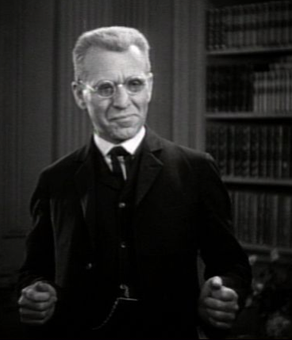
Professor Abraham Van Helsing is a fictional character from the 1897 gothic horror novel Dracula written by Bram Stoker. Van Helsing is a Dutch polymath doctor with a wide range of interests and accomplishments, partly attested by the string of letters that follows his name: "MD, D.Ph., D.Litt., etc.", indicating a wealth of experience, education and expertise. He is a doctor, professor, lawyer, philosopher, scientist, and metaphysician. The character is best known through many adaptations of the story as a vampire slayer, monster hunter and the arch-nemesis of Count Dracula, and the prototypical and the archetypical parapsychologist in subsequent works of paranormal fiction. Some later works tell new stories about Van Helsing, while others, such as Dracula (2020) and I Woke Up a Vampire (2023) have characters that are his descendants.

R. M. Renfield is a fictional character who appears in Bram Stoker's 1897 Gothic horror novel Dracula. He is Count Dracula's deranged, fanatically devoted servant and familiar, helping him in his plan to turn Mina Harker into a vampire in return for a continuous supply of insects to consume and the promise of immortality. Throughout the novel, he resides in an asylum, where he is treated by Dr. John Seward.
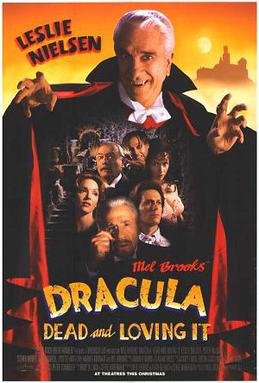
Dracula: Dead and Loving It is a 1995 comedy horror film directed by Mel Brooks and starring Leslie Nielsen. It is a spoof of Bram Stoker's novel Dracula and of some of the story's well-known adaptations.

Dracula is a 1931 American pre-Code supernatural horror film directed and co-produced by Tod Browning from a screenplay written by Garrett Fort and starring Bela Lugosi in the title role. It is based on the 1924 stage play Dracula by Hamilton Deane and John L. Balderston, which in turn is adapted from the 1897 novel Dracula by Bram Stoker. Lugosi portrays Count Dracula, a vampire who emigrates from Transylvania to England and preys upon the blood of living victims, including a young man's fiancée.
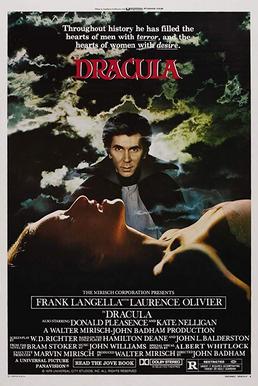
Dracula is a 1979 gothic horror film directed by John Badham. The film starred Frank Langella in the title role as well as Laurence Olivier, Donald Pleasence and Kate Nelligan.

Igor, or sometimes Ygor, is a stock character, a sometimes hunch-backed laboratory assistant to many types of Gothic villains or as a fiendish character who assists only himself, the latter most prominently portrayed by Bela Lugosi in Son of Frankenstein (1939) and The Ghost of Frankenstein (1942). He is familiar from many horror films and horror film parodies. He is traditionally associated with mad scientists, particularly Victor Frankenstein, although Frankenstein has neither a lab assistant nor any association with a character named Igor in the original Mary Shelley novel. The Igor of popular parlance is a composite character, based on characters created for the Universal Studios film franchise. In the first Frankenstein film (1931), Fritz served the role; in subsequent sequels, a different physically deformed character, Ygor, is featured, though Ygor is not an assistant in those films.

Bela Lugosi (1882–1956), best known for the original screen portrayal of Bram Stoker's Dracula in 1931, performed in many films during the course of his 39-year film career. He appeared in films made in his native Hungary, Germany and New York before re-locating to Hollywood in 1928. Films are listed in order of release.

Dracula's Daughter is a 1936 American vampire horror film produced by Universal Pictures as a sequel to the 1931 film Dracula. Directed by Lambert Hillyer from a screenplay by Garrett Fort, the film stars Otto Kruger, Gloria Holden in the title role, and Marguerite Churchill, and features, as the only cast member to return from the original, Edward Van Sloan – although his character's name was altered from "Van Helsing" to "Von Helsing".
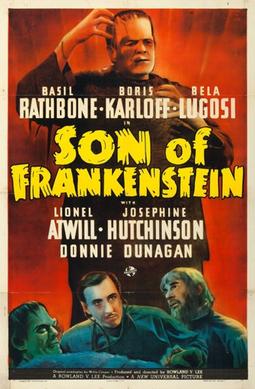
Son of Frankenstein is a 1939 American horror film directed by Rowland V. Lee and starring Basil Rathbone, Boris Karloff and Bela Lugosi. The film is the third in Universal Pictures' Frankenstein series and is the follow-up to the 1935 film Bride of Frankenstein. Son of Frankenstein stars Rathbone as Baron Wolf von Frankenstein who, with his wife Elsa and son Peter, returns to his late father's estate. Near the castle lives Ygor, a crazed blacksmith whose neck was broken in an unsuccessful hanging attempt. Among the castle's remains, Frankenstein discovers the remains of the Monster and decides to try to save his family name by resurrecting the creature to prove his father was correct. He finds, however, the Monster only responds to Ygor's commands.

Son of Dracula is a 1943 American horror film directed by Robert Siodmak with a screenplay based on an original story by his brother Curt Siodmak. The film stars Lon Chaney Jr., Louise Allbritton, Robert Paige, Evelyn Ankers, and Frank Craven. The film is set in the United States, where Count Alucard has just taken up residence. Katherine Caldwell (Allbritton), a student of the occult, becomes fascinated by Alucard and eventually marries him. Katherine begins to look and act strangely, leading her former romantic partner Frank Stanley (Paige) to suspect that something has happened to her. He gets help from Dr. Brewster (Craven) and psychologist Laszlo who come to the conclusion that Alucard is a vampire.

House of Frankenstein is a 1944 American horror film starring Boris Karloff, Lon Chaney Jr. and John Carradine. Based on a story by Curt Siodmak, it was directed by Erle C. Kenton and produced by Universal Pictures. Based on Curt Siodmak's story The Devil's Brood, the film is about Dr. Gustav Niemann, who escapes from prison and promises to create a new body for his assistant Daniel. Over the course of the film, they encounter Count Dracula, Larry Talbot, the Wolf Man, and Frankenstein's Monster.

House of Dracula is a 1945 American horror film released and distributed by Universal Pictures. Directed by Erle C. Kenton, the film features several Universal Horror properties meeting as they had done in the 1944 film House of Frankenstein. The film is set at the castle home of Dr. Franz Edelmann, who is visited first by Count Dracula and later by Larry Talbot, the Wolf Man, who are trying to cure their vampirism and lycanthropy, respectively. Talbot is eventually cured, which leads him to discover the body of Frankenstein's monster in a cave below the base of the castle. Edelemann takes the monster's body back to his laboratory but finds Count Dracula has awakened and by attacking his assistants, he captures Edelmann and forces a reverse blood transfusion, which gives Edelmann a split personality and makes him a killer.

Universal Classic Monsters is a media franchise based on a series of horror films primarily produced by Universal Pictures from the 1930s to the 1950s. The films were marketed as a line in the early 1990s to suggest to audiences that they were all part of a connected series.

Murders in the Rue Morgue is a 1932 American horror film directed by Robert Florey, based on Edgar Allan Poe's 1841 short story "The Murders in the Rue Morgue". The plot is about Doctor Mirakle, a carnival sideshow entertainer and scientist who kidnaps Parisian women to mix their blood with that of his gorilla, Erik. As his experiments fail because of the quality of his victims' blood, Mirakle meets with Camille L'Espanye, and has her kidnapped and her mother murdered, leading to suspicion falling on Camille's fiance, Pierre Dupin, a medical student who has already become interested in the earlier murders.

Dracula is a 1931 Spanish-language American horror film directed by George Melford. The film is based on both the novel Dracula by Bram Stoker and the play Dracula by Hamilton Deane and John L. Balderston. The film is about Renfield, who travels to Translyvania to visit Conde Drácula. He is drugged by the Count and becomes his minion. The two travel to England, where Drácula begins to seduce Lucía Weston as she becomes his first victim. This leads Professor Van Helsing to investigate, who confirms that Drácula is a vampire.
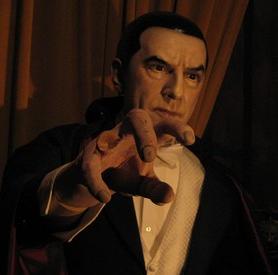
The character of Count Dracula from the 1897 novel Dracula by Bram Stoker, has remained popular over the years, and many forms of media have adopted the character in various forms. In their book Dracula in Visual Media, authors John Edgar Browning and Caroline Joan S. Picart declared that no other horror character or vampire has been emulated more times than Count Dracula. Most variations of Dracula across film, comics, television and documentaries predominantly explore the character of Dracula as he was first portrayed in film, with only a few adapting Stoker's original narrative more closely. These including borrowing the look of Count Dracula in both the Universal's series of Dracula and Hammer's series of Dracula, including include the characters clothing, mannerisms, physical features hair style and his motivations such as wanting to be in a home away from Europe.

Dracula is a stage play written by the Irish actor and playwright Hamilton Deane in 1924, then revised by the American writer John L. Balderston in 1927. It was the first authorized adaptation of Bram Stoker's 1897 novel Dracula. After touring in England, the original version of the play appeared at London's Little Theatre in July 1927, where it was seen by the American producer Horace Liveright. Liveright asked Balderston to revise the play for a Broadway production that opened at the Fulton Theatre in October 1927. This production starred Bela Lugosi in his first major English-speaking role.

Frankenstein is a film series of horror films from Universal Pictures based on the play version by Peggy Webling and the 1818 novel Frankenstein; or, The Modern Prometheus by Mary Shelley. The series follow the story of a monster created by Henry Frankenstein who is made from body parts of corpses and brought back to life. The rest of the series generally follows the monster continuously being revived and eventually focuses on a series of cross overs with other Universal horror film characters such as The Wolf Man. The series consists of the following films: Frankenstein (1931), Bride of Frankenstein (1935), Son of Frankenstein (1939), The Ghost of Frankenstein (1942), Frankenstein Meets the Wolf Man (1943), House of Frankenstein (1944), House of Dracula (1945) and Abbott and Costello Meet Frankenstein (1948).

The history of horror films was described by author Siegbert Solomon Prawer as difficult to read as a linear historical path, with the genre changing throughout the decades, based on the state of cinema, audience tastes and contemporary world events.



















